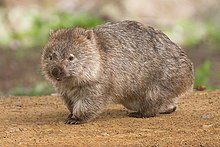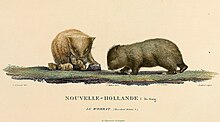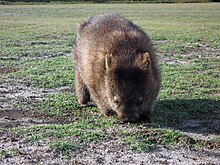웜뱃
Common wombat| 웜뱃[1] | |
|---|---|
 | |
| 태즈메이니아 마리아 섬 봄바투스 우르시누스 | |
| 과학적 분류 | |
| 도메인: | 진핵생물 |
| 킹덤: | 애니멀리아 |
| 문: | 초르다타 |
| 클래스: | 포유류 |
| 인프라 클래스: | 마르수피알리아 |
| 순서: | 디프로토돈티아 |
| 가족: | 봄바티과 |
| 속: | 봄바투스속 |
| 종: | V. ursinus |
| 이항명 | |
| 볼바투스 우르시누스 (쇼, 1800) | |
 | |
| 일반웜뱃사거리 | |
| 동의어 | |
| 참조[3]
| |
거친털웜뱃 또는 맨코웜뱃으로도 알려진 일반 웜뱃은 유대류로 현존하는 3종의 웜뱃 중 하나이며, 웜뱃속에 속하는 유일한 웜뱃입니다.보통 웜뱃은 평균 98cm 길이에 26kg의 몸무게까지 자랍니다.
분류학

일반적인 웜뱃은 1800년 조지 쇼에 의해 처음으로 묘사되었습니다.현존하는 아종은 3종입니다.
- 이름붙인 형태인 Bass Strait (흔한) 웜뱃 (V. u. ursinus)은 한때 Bass Strait 제도 전역에서 발견되었지만, 현재는 Tasmania 북쪽의 Flinders 섬에 제한되어 있습니다.[4]1996년에 개체수는 4,000마리로 추정되었고 1999년 환경보호 및 생물다양성 보전법과 IUCN 적색 목록에 의해 취약종으로 분류되었습니다.[5][6]
- 히르수테 웜뱃(V. u. hirsutus)은 호주 본토에서 발견됩니다.[4]
- 태즈메이니아 웜뱃(V. u. tasmaniensis)은 태즈메이니아에서 발견됩니다.[4][7]그것은 V. u. hirsutus 보다 작습니다.[8]
해켓웜뱃(V. hacketti)은 호주 남서부에 서식하는 볼바투스 속의 멸종된 종입니다.[9][10][11][12]V. ursinus와 비슷한 크기로 평균 몸무게 30kg의 V. hacketti는 후기 플라이스토세 말, 제4차 멸종 사건에서 멸종되었습니다.[13][14]
묘사
보통 웜뱃은 튼튼하고 땅에 가까이 지어져 있습니다.다 자라면, 그들은 80에서 130cm에 이를 수 있고, 무게는 17에서 40kg에 이릅니다.태즈메이니아 섬과 플린더스 섬에서 발견되는 웜뱃은 종종 본토의 웜뱃보다 작습니다.대머리 코 때문에 털코 웜뱃과 구별됩니다.
분포 및 서식지

흔히 볼 수 있는 웜뱃은 태즈메이니아와 빅토리아를 포함한 오스트레일리아 남부와 동부의 시원하고 물이 더 좋은 지역과 퀸즐랜드주 남부의 북쪽 멀리 산악 지역에 널리 분포합니다.[15][16]
일반 웜뱃은 서식지 남쪽의 어느 고도에서나 발견되지만, 서식지 북쪽에서는 더 높은 산 지역에서만 발견됩니다.열대 우림, 유칼립투스 숲, 삼림 지대, 고산 초원, 해안 지역을 포함한 다양한 서식지에서 발견될 수 있습니다.[17]일부 지역에서는 농경지에 적응했고 심지어 소와 양이 있는 들판에서 풀을 뜯는 모습도 볼 수 있습니다.
행동
보통 웜뱃은 굴을 파서 흙을 만들고 공기를 주입하여 식물의 성장을 돕고 무척추동물과 척추동물 종의 다양한 서식지를 제공하기 때문에 생태 [18]공학자로 묘사되어 왔습니다.[19][20]
일반 웜뱃은 단독 생활을 하는 영역의 종으로 각 웜뱃이 서식하고 먹이를 먹는 일정한 범위를 가지고 있습니다.[21]이 지역에서 그들은 터널 시스템을 파는데, 길이가 2m에서 20m에 이르는 터널들과 많은 측면 터널들이 있습니다.보통, 굴로 들어가는 입구는 하나뿐이지만, 굴이 탈출할 수 있는 작은 입구를 만들 수도 있습니다.
파충류, 설치류, 토끼, 바늘두더지, 왈라비, 새, 코알라를 포함한 다양한 다른 동물들이 웜뱃 굴을 사용하는 것으로 알려져 있습니다.웜뱃은 일반적으로 위협적이지 않은 종들에 대해 상당히 관대하고, 그들이 차지할 수 있는 많은 굴들을 가지고 있습니다.[22][23]
많은 웜뱃들은 같은 굴에서 살 수 있고, 웜뱃이 농부나 다른 동물 종에 의해 굴 밖으로 내몰리거나 굴이 파괴되지 않는 한 웜뱃은 보통 평생 같은 굴에서 삽니다.흔히 야행성인 웜뱃은 이른 아침이나 늦은 오후와 같은 더 시원한 날씨에 낮에 나타납니다.[24]
다이어트

맨코 웜뱃은 초식성 동물로 풀, 눈 송곳니, 그리고 다른 식물들을 먹고 삽니다.먹이를 찾는 일은 주로 밤에 이루어집니다.그들은 끊임없이 이빨이 자라는 세계에서 유일한 유대목 동물입니다.치아의 근본적인 에나멜 구조 때문에, 지속적으로 자라는 치아는 주로 토종 풀로 구성된 식단을 더 쉽게 방목할 수 있도록 하는 스스로 날카로운 능선을[25] 유지합니다.[24]포획된 웜뱃은 또한 다양한 채소를 먹습니다.[26]
번식
보통 웜뱃은 2년마다 번식을 하고 한 마리의 조이를 생산할 수 있습니다.웜뱃은 옆으로[27] 짝짓기를 하는 것처럼 보입니다. 임신 기간은 약 20일에서 30일 정도이고 아기는 5개월 동안 주머니에 남아 있습니다.파우치를 떠날 때 무게는 3.5~6.5kg(7.7~14.3lb) 사이입니다.조이는 생후 12개월에서 15개월 정도 젖을 떼게 되며, 보통 생후 18개월에 독립적입니다.[24]웜뱃의 평균 수명은 야생에서 15년, 사육 상태에서는 20년입니다.
위협
맨코웜뱃은 IUCN이 '관심대상종'으로 선정했지만,[28] 주로 서식지 감소, 로드킬(roadkill[30]), 사르코틱 망아지(sarcoptic mange)[31] 등 의인화된 요인으로[29] 인해 위협을 받고 있습니다.근친상간은 개체수에[32] 널리 퍼져 있으며 야생동물 보호자들이 정기적으로 저위험 뜸부기로 현장에서[33][34] 웜뱃을 치료하는 가운데 맨코 웜뱃이 직면한 문제 중 가장 문제가 되고 있습니다.[35]
웜뱃은 진드기와 관련 병원균을[36][37] 포함한 다양한 기생충을 보유하고 있는 것으로 보고되었습니다.
참고문헌
- ^ Groves, C. P. (2005). "Genus Vombatus ursinus". In Wilson, D. E.; Reeder, D. M. (eds.). Mammal Species of the World: A Taxonomic and Geographic Reference (3rd ed.). Baltimore: Johns Hopkins University Press. pp. 43–44. ISBN 0-801-88221-4. OCLC 62265494.
- ^ Taggart, D.; Martin, R.; Menkhorst, P. (2016). "Vombatus ursinus". IUCN Red List of Threatened Species. 2016: e.T40556A21958985. doi:10.2305/IUCN.UK.2016-2.RLTS.T40556A21958985.en. Retrieved 12 November 2021.
- ^ S. Jackson; C. Groves (2015). Taxonomy of Australian Mammals. p. 101.
- ^ a b c "Common Wombat". Department of Primary Industries, Parks, Water and Environment. Retrieved 13 December 2009.
- ^ 웜뱃(Vombatus ursinus ursinus) — 흔한웜뱃 (Bass 해협)
- ^ Australasian Marsupial & Monotreme Specialist Group (1996). "Vombatus ursinus ssp. ursinus". IUCN Red List of Threatened Species. 1996. Retrieved 15 March 2007.
- ^ Spencer, Walter Baldwin; Kershaw, James A. (1910). The existing species of the genus Phascolomys. Memoirs of the National Museum of Victoria, Melbourne. Vol. 3. Melbourne: J. Kemp, government printer.
- ^ "Common Wombat". Wombania's Wombat Information Center. Retrieved 13 December 2009.
- ^ "Megafauna". austhrutime.com. Retrieved 2017-04-20.
- ^ Triggs, Barbara (2009-01-01). Wombats. Csiro Publishing. ISBN 9780643096011.
- ^ "Anaspides.net". www.anaspides.net. Archived from the original on 2017-07-20. Retrieved 2017-04-20.
- ^ Johnson (2002). "Determinants of loss of mammal species during the Late Quaternary 'megafauna' extinctions: life history and ecology, but not body size". Proc. R. Soc. Lond. B 269 (1506): 2221–2227. doi:10.1098/rspb.2002.2130. PMC 1691151. PMID 12427315.
- ^ "The Recently Extinct Plants and Animals Database cubit: The Recently Extinct Plants and Animals Database Extinct Mammals: Marsupials: Vombatus hacketti". cubits.org. Archived from the original on 2017-04-20. Retrieved 2017-04-20.
- ^ MacPhee, R. D. E. (1999-06-30). Extinctions in Near Time. Springer Science & Business Media. ISBN 9780306460920.
- ^ Thorley RK, Old JM (2020).분포, 풍부함 그리고 맨코 웜뱃에 대한 위협 (Vombatus ursinus).오스트레일리아 포유류.42, 249-256.DOI: 10.1071/AM19035
- ^ "Bare-nosed wombat Vombatus ursinus" (PDF). Queensland Government. Queensland Government. 2022-09-16. Retrieved 2022-10-05.
- ^ Thorley, Rowan K.; Old, Julie M. (2020). "Distribution, abundance and threats to bare-nosed wombats (Vombatus ursinus)". Australian Mammalogy. 42 (3): 249. doi:10.1071/AM19035. S2CID 213536628.
- ^ Old, Julie M.; Lin, Simon H.; Franklin, Michael J. M. (December 2019). "Mapping out bare-nosed wombat (Vombatus ursinus) burrows with the use of a drone". BMC Ecology. 19 (1): 39. doi:10.1186/s12898-019-0257-5. PMC 6749681. PMID 31533684. S2CID 202641093.
- ^ Old, Julie M.; Hunter, NE; Wolfenden, J (2018). "Who utilises bare-nosed wombat burrows?". Australian Zoologist. 39 (3): 409–413. doi:10.7882/AZ.2018.006. S2CID 135128293.
- ^ Fleming, PA; Anderson, H; Prendergast, AS; Bretz, MR; Valentine, LE; Hardy, GES (2014-04-01). "Is the loss of Australian digging mammals contributing to a deterioration in ecosystem function?". Mammal Review. 44 (2): 94–108. doi:10.1111/mam.12014.
- ^ "Living with wombats". NSW Department of Planning and Environment. NSW Government. 2022-02-17. Retrieved 2022-10-05.
- ^ "Australian bushfires: animals that take refuge in wombat burrows usually uninvited, experts say". AFP Fact Check. 20 January 2020. Retrieved 13 December 2022.
- ^ Nimmo, Dale (15 January 2020). "Viral stories of wombats sheltering other wildlife from the bushfires aren't entirely true". ABC News. Retrieved 13 December 2022.
- ^ a b c "Wombats, Wombat Pictures, Wombat Facts". National Geographic Society. 11 April 2010. Retrieved 21 July 2011.
- ^ Ferreira, J. M.; Phakey, P. P.; Palamara, J.; Rachinger, W. A.; Orams, H. J. (1989). "Electron microscopic investigation relating the occlusal morphology to the underlying enamel structure of molar teeth of the wombat (Vombatus ursinus)". Journal of Morphology. 200 (2): 141–149. doi:10.1002/jmor.1052000204. PMID 29865656. S2CID 46929011.
- ^ Stannard, Hayley J.; Purdy, Katherine; Old, Julie M. (2021). "A survey and critical review of wombat diets in captivity". Australian Mammalogy. 43 (1): 66. doi:10.1071/AM20028. S2CID 225365567.
- ^ Stannard, Hayley; Old, Julie. "A rare video of wombats having sex sideways offers a glimpse into the bizarre realm of animal reproduction". The Conversation.
- ^ "IUCN Red List".
- ^ Thorley, Rowan K.; Old, Julie M. (2020). "Distribution, abundance and threats to bare-nosed wombats (Vombatus ursinus)". Australian Mammalogy. 42 (3): 249. doi:10.1071/AM19035. S2CID 213536628.
- ^ Mayadunnage, S.; Stannard, H. J.; West, P.; Old, J. M. (6 July 2022). "Identification of roadkill hotspots and the factors affecting wombat vehicle collisions using the citizen science tool, WomSAT". Australian Mammalogy. 45 (1): 53–61. doi:10.1071/AM22001.
- ^ Old, J. M.; Sengupta, C.; Narayan, E.; Wolfenden, J. (April 2018). "Sarcoptic mange in wombats-A review and future research directions". Transboundary and Emerging Diseases. 65 (2): 399–407. doi:10.1111/tbed.12770. PMID 29150905.
- ^ Old, J. M.; Sengupta, C.; Narayan, E.; Wolfenden, J. (April 2018). "Sarcoptic mange in wombats-A review and future research directions". Transboundary and Emerging Diseases. 65 (2): 399–407. doi:10.1111/tbed.12770. PMID 29150905.
- ^ Old, J. M.; Sengupta, C.; Narayan, E.; Wolfenden, J. (April 2018). "Sarcoptic mange in wombats-A review and future research directions". Transboundary and Emerging Diseases. 65 (2): 399–407. doi:10.1111/tbed.12770. PMID 29150905.
- ^ Old, Julie M.; Skelton, Candice J. A.; Stannard, Hayley J. (March 2021). "The use of Cydectin® by wildlife carers to treat sarcoptic mange in free-ranging bare-nosed wombats (Vombatus ursinus)". Parasitology Research. 120 (3): 1077–1090. doi:10.1007/s00436-020-07012-8. PMID 33438043. S2CID 231595549.
- ^ Schraven, Andrea L.; Stannard, Hayley J.; Old, Julie M. (April 2021). "A systematic review of moxidectin as a treatment for parasitic infections in mammalian species". Parasitology Research. 120 (4): 1167–1181. doi:10.1007/s00436-021-07092-0. S2CID 231989259.
- ^ Beard, Danielle; Stannard, Hayley J.; Old, Julie M. (February 2021). "Parasites of wombats (family Vombatidae), with a focus on ticks and tick-borne pathogens". Parasitology Research. 120 (2): 395–409. doi:10.1007/s00436-020-07036-0. PMID 33409643. S2CID 253981632.
- ^ Beard, Danielle; Stannard, Hayley J.; Old, Julie M. (December 2021). "Morphological identification of ticks and molecular detection of tick-borne pathogens from bare-nosed wombats (Vombatus ursinus)". Parasites & Vectors. 14 (1): 60. doi:10.1186/s13071-020-04565-6. PMC 7814742. PMID 33468211.





